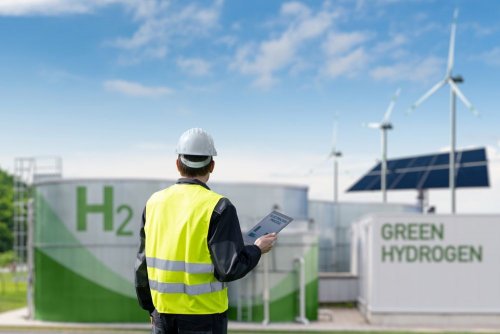In Sweden, steelmaker SSAB has joined forces with mining company LKAB and electricity supplier Vattenfall in the HYBRIT project, which will see the steel industry completely off fossil fuels and carbon in 20 years.
HYBRIT technology relies on green hydrogen in direct reduction units as an environmentally friendly alternative to traditional coal-fired blast furnaces, reports GreenSteelWorld.
The traditional process of steel production is a threat to the future, because the use of coking coal in the steel industry has significant carbon emissions. Sweden aims to become the world's first fossil fuel-free welfare state, and HYBRIT – short for Hydrogen Breakthrough Ironmaking Technology – is a quantitative leap in that direction.
HYBRIT's first fossil-free sponge iron pilot plant in Luleå opened in August 2020
The project is expected to produce approximately 1.35 million tons of hydrogen-reduced pig iron annually, which will be used for the production of crude steel, which is approximately 25% of Sweden's total production.
Calculations by the EU Innovation Fund showed that it would reduce greenhouse gas emissions by 14.3 million tons of CO₂ during the first 10 years of operation.
HYBRIT dense objects:
- The LKAB pellet plant in Malmberget is the world's first fossil-free pellet plant. In the fall of 2020, successful attempts were made to produce the world's first iron ore pellets with bio-oil.
- Direct reduction with hydrogen in Luleå – The plant has a direct reduction reactor where hydrogen reduces iron ore to iron. At this facility, hydrogen is produced by electrolysis of water using electricity without the use of fossil fuels.
- Hydrogen storage in Luleå – green hydrogen is a key element of HYBRIT's success, so to ensure a fossil fuel-free hydrogen supply, it is important to be able to store it in safe and efficient conditions.
- Luleå Sponge Iron Smelter – The plant is experimenting with the smelting of sponge iron, HBI (Hot Briquetted Iron), which is the result of the direct reduction of iron ore in the so-called DRI.
The main directions of the HYBRIT research program:
- supply of electricity without the use of fossil fuels;
- production and storage of hydrogen;
- production of fossil-free iron ore pellets;
- hydrogen reduction of iron ore;
- production of steel from iron ore reduced by hydrogen
- to meet the market.
Industrial installations for HYBRIT should appear in 2030-2040, and from 2045 it is planned to be 100% fossil fuel-free. Over time, SSAB plans to transition all of its businesses and provide a fossil fuel-free value chain for the automotive and heavy-duty industries as soon as possible.
In 2021, SSAB supplied Volvo Group with the first fossil-free steel produced at the HYBRIT pilot plant in Luleå. Then the company produced a prototype of the world's first vehicle using green steel.
"By 2026, our goal is to put fossil-free steel on the market and demonstrate the technology on an industrial scale," the article says.
In November 2021, the European Union announced that it will invest a total of more than €1.1 billion in seven large-scale innovation projects under the Innovation Fund. HYBRIT is the only project in metallurgy that received support in the first competition. The project received a total of €143 million.
HYBRIT is paving the way for a fundamental change in the global steel industry. It also demonstrates how fast the green transition can happen: a few years ago, the possibility of producing emission-free steel would have sounded like science fiction. Now, green steel is entering the market. The support granted via the Innovation Fund is testament to the importance and potential of this technology, and the European Commission is convinced that this cuttingedge project will boost the European Union’s overall competitiveness. Green steel has the future, and that future is already here”, said Frans Timmermans, Executive Vice President of the European Commission responsible for the European Green Deal.
According to Martin Lindqvist, president and CEO of SSAB, the demand for environmentally friendly consumption is increasing and fossil-free steel will become the new normal. He predicts that HYBRIT will be a game-changer in conceptualizing something that was unimaginable just a few years ago.
Doctor Martin Pei, Executive Vice President and CTO of SSAB, noted that with HYBRIT, the joint venture partners want to make a global impact, and that is why they are working hard to make the technology more stable and sustainable. SSAB aims to develop this technology on a commercial scale and be the first to bring fossil-free steel to market, but over time they are open to sharing their technology with the rest of the world.
In addition, SSAB has invested heavily in fossil-free steel, and as part of this, the manufacturing process will be documented in an Environmental Product Declaration (EPD). EDP tells the story of a product's life cycle in a single, comprehensive report.
" It seems safe to say that green steel is picking up steam in Europe and many other parts of the world. The consumers are becoming aware and there is an increasing demand for sustainable value chains across all industries. For companies, it is a chance to make carbon neutrality a strategic competitive advantage and a moral responsibility. People are waking up to the urgency of the climate situation and now is the time for companies to ensure their businesses are fit for the future," the article concluded.
Earlier, EcoPolitic wrote, that Austrian steel company Voestalpine has shipped the first batch of steel coils to customers with low carbon, made by greentec Steel Edition technology.
As EcoPolitic previously reported, the Verkovna Rada signed a memorandum of understanding with Thyssenkrupp Steel (Germany) on the development of long-term supplies of low-carbon hydrogen and green energy in steel production.





